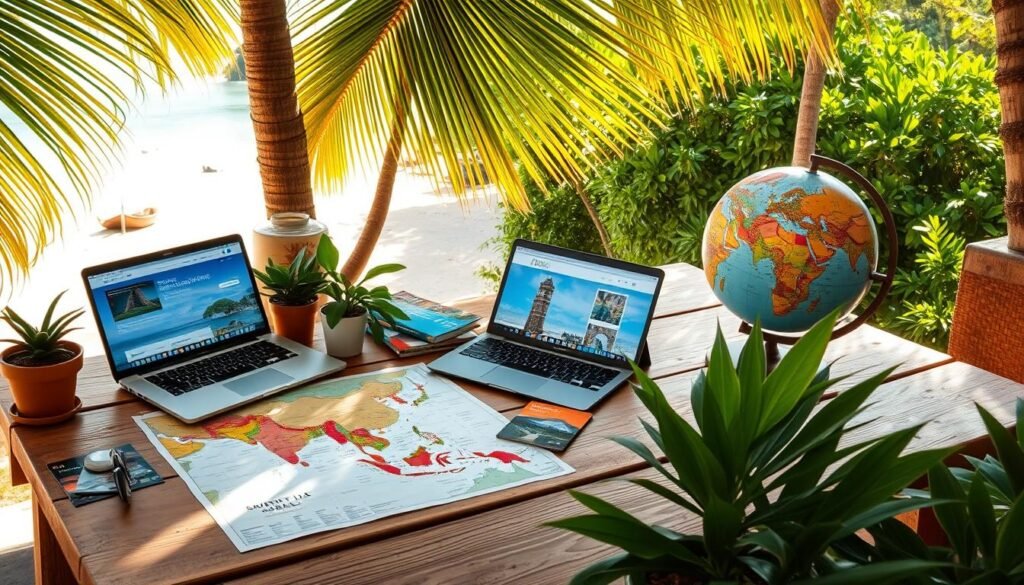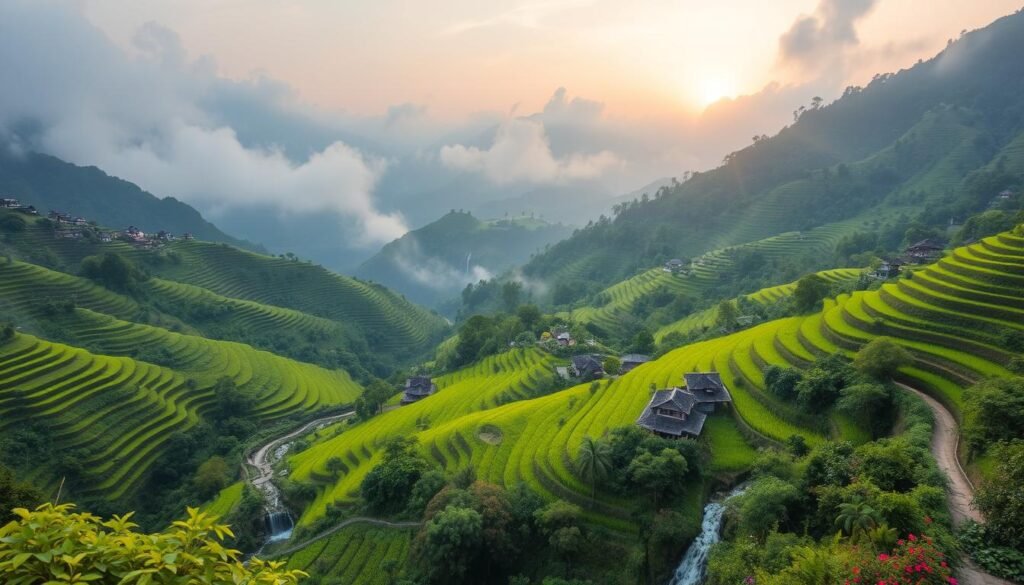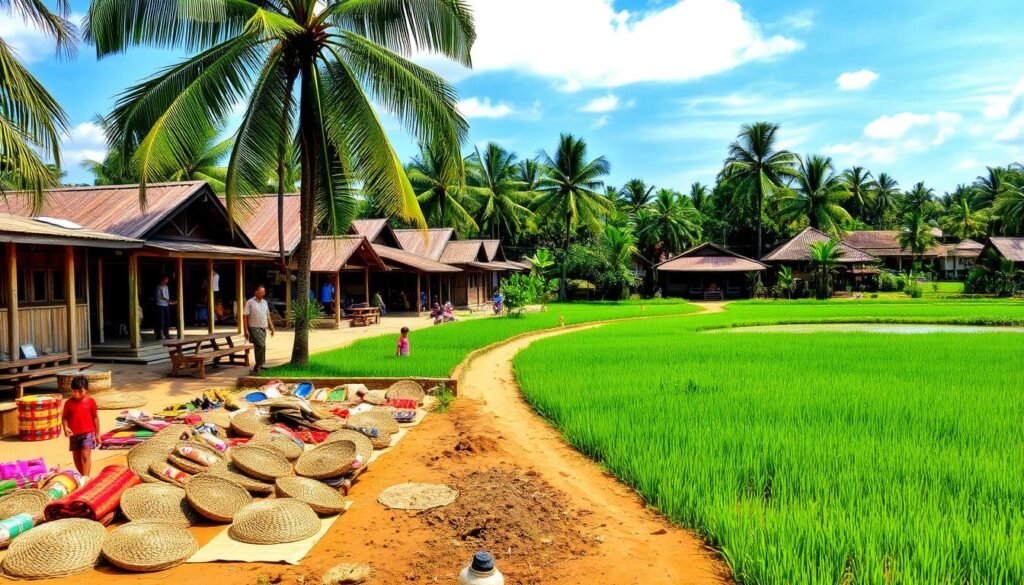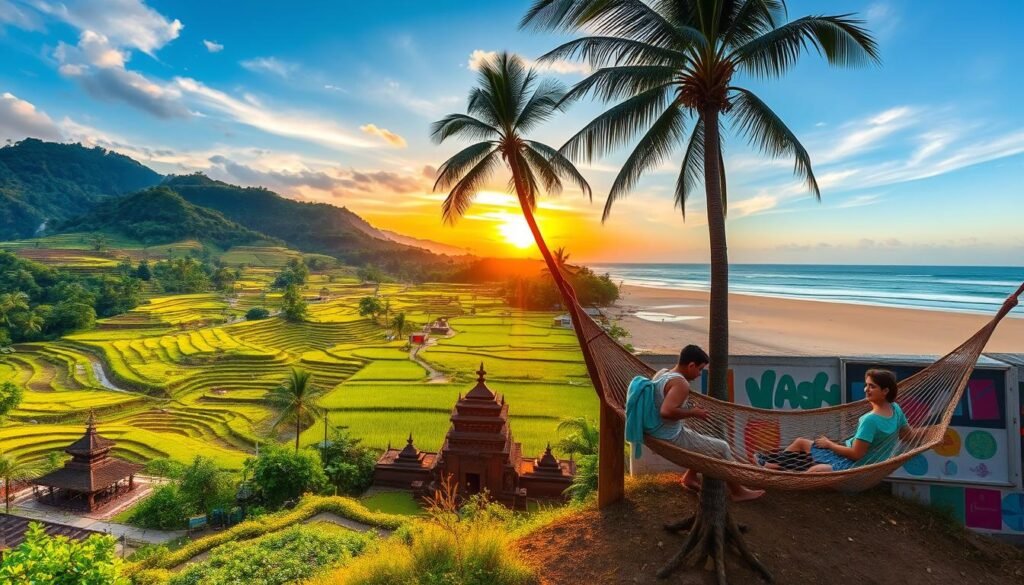Thinking about heading off the beaten path in Southeast Asia? From ancient cave temples to island archipelagos, the region is filled with under-the-radar destinations perfect for 2025. Skip the tourist-packed cities and dive into quieter corners that offer jaw-dropping nature, rich culture, and unique activities — many of which you can now book online.
This post may contain affiliate links. If you make a purchase or booking through one of our links, we may earn a small commission. As an Amazon Associate, I earn from qualifying purchases. The content on this website was created with the help of AI.
Here are 10 hidden gems in Southeast Asia worth exploring, complete with what to expect, insider tips, and where to stay.

1. Hpa-An, Myanmar
Tucked away in Myanmar’s Kayin State, Hpa-An is a peaceful town surrounded by dramatic limestone mountains and mysterious caves. It’s a paradise for nature lovers and cultural explorers. You can book a full-day guided cave and countryside tour that covers Kawgun Cave, Saddan Cave, the Kyauk Ka Lat Pagoda, and a scenic boat ride along the river.
What to expect: Expect panoramic views from Mount Zwegabin, golden Buddhas tucked inside stalactite-filled caves, and encounters with friendly local villagers. The vibe is unhurried and authentic.
Tips: Visit between November and February for dry weather. Rent a motorbike to freely explore caves and rice fields. Start early to avoid midday heat in the caves.
Hidden gem: Don’t miss the boat that takes you through Saddan Cave — it exits into a quiet lake ringed by cliffs and rice paddies.
Where to stay: Stay at Vintage Hpa-An Hotel for luxury rooms at hotel rates or try Soe Brothers Guesthouse for a backpacker-friendly base.
2. Si Phan Don (4,000 Islands), Laos
At the southern tip of Laos lies Si Phan Don — a tranquil archipelago on the Mekong River where life slows to a crawl. This area is ideal for kayaking tours, sunset cruises, and seeing the rare Irrawaddy dolphins. You can book eco-tours and river-based excursions via Viator or local guides on Don Khon.
What to expect: Palm-dotted islands with no cars, rope swing riverbanks, thundering waterfalls like Khone Phapheng, and locals fishing from longboats. Don Det is a favorite for budget travelers, while Don Khon offers more peace and better access to nature.
Tips: Bring cash — there are no ATMs. Ferries run sporadically, so plan your transfers. Dry season (Nov–April) is best for river activities.
Hidden gem: Visit Liphi Waterfall (aka the Devil’s Corridor) early in the morning for maximum mist and solitude.
Where to stay: Little Eden Hotel on Don Det for a mid-range riverfront stay, or Sala Done Khone for colonial-style charm on Don Khon.
3. Belitung Island, Indonesia
Often overlooked in favor of Bali or Lombok, Belitung is a white-sand wonderland with otherworldly granite rock formations, clear waters, and postcard-worthy beaches. Book a boat-hopping tour to Lengkuas Island, Batu Garuda, and snorkel the colorful reefs.
What to expect: Empty beaches, turquoise lagoons, and ancient Dutch lighthouses on remote islets. The town of Tanjung Pandan offers a glimpse of sleepy coastal life.
Tips: Visit between May and October for sunny skies and calm seas. Pack reef-safe sunscreen and a drone — the aerial views are incredible.
Hidden gem: Check out Kaolin Lake, a surreal, bright blue water pit left behind by mining — it looks like Iceland meets Indonesia.
Where to stay: Sheraton Belitung Resort offers beachfront luxury and full service. For boutique style, try Hotel Santika Premiere Beach Resort.
4. Luang Prabang Countryside, Laos
Beyond Luang Prabang’s gilded temples lies a lush countryside dotted with waterfalls, rice paddies, and weaving villages. Book a Kuang Si Waterfalls day tour with stops at minority villages and local farms — available via GetYourGuide and Viator.
What to expect: Hike to turquoise swimming holes, visit rescued moon bears at the Tat Kuang Si Bear Sanctuary, and sample sticky rice cooked in bamboo.
Tip: Arrive at the waterfalls early to avoid the crowds. Bring a towel and swimwear — the water is chilly but refreshing.
Hidden gem: Join a local cooking class in Ban Na Ouane village for an unforgettable farm-to-table experience.
Where to stay: My Dream Boutique Resort is ideal for a serene riverside getaway. Budget travelers love Matata Garden Guesthouse for its family-run charm.
5. Kep, Cambodia
Formerly a French seaside retreat, Kep is a charming and quiet alternative to Sihanoukville. With its famous crab market, peaceful beaches, and jungle-topped hills, it’s a great escape for foodies and nature lovers. Book a Kep National Park hiking and pepper plantation tour via Viator.
What to expect: Scenic mountain trails, spicy Kampot pepper farms, and a chilled-out beach with some of the best seafood in Cambodia.
Tips: Order crab stir-fried with Kampot pepper at the market. Rent a scooter to explore hidden coves and trails.
Hidden gem: Visit Koh Tonsay (Rabbit Island), just 30 minutes by boat — it’s a backpacker’s beach paradise with $10 bungalows.
Where to stay: Knai Bang Chatt is a stylish boutique resort on the water. For budget stays, try Raingsey Bungalow tucked in the hills.

6. Kampot & Kep, Cambodia
This duo of riverside Kampot and coastal Kep offers a peaceful retreat brimming with colonial charm, pepper farms, and ocean breezes. A popular full‑day tour from Phnom Penh combines pepper plantation visits, salt fields, Phnom Chhngok cave, Kep beach, crab market scene, and a seafood lunch.
What to expect: Kampot’s serene riverside town features colonial architecture, while Kep provides a relaxed beach vibe and fresh seafood at its famous crab market. Between them are trails through Kep National Park and visits to pepper farms and salt flats.
Tips: Try Kampot pepper straight from the plantation. Time your visit for late afternoon for sunset on Kep Beach. Wear comfy shoes for hiking in Kep National Park’s jungle trails.
Hidden gem: Take the quick boat ride to Koh Tonsay (“Rabbit Island”) for a day on pristine beaches, rented hammocks, and grilled seafood right on the sand.
Where to stay: Choose Knai Bang Chatt for stylish colonial-era architecture, spa access, and seafront dining at its Sailing Club restaurant; Vine Retreat and Villa Romonea are budget‑friendly with great crab dishes and views.
7. Chiang Dao, Thailand
Tucked beneath towering limestone cliffs just north of Chiang Mai, Chiang Dao is a serene mountain town known for its cave systems, lush rice terraces, and local hill tribes. Guided excursions here often include visits to Chiang Dao Cave, hot springs, and visits with Karen or Hmong communities, available on Viator and local platforms.
What to expect: Breathe in the forest air, explore expansive cave temples lit by rays of sunlight, soak in natural hot springs, and meet local artisans in remote villages.
Tips: Best visited between November and February when mist settles in the valleys. Pack layers and good walking shoes for hiking and cave explorations.
Hidden gem: Venture beyond the main cave to Elephant Cave (Tham Chang) and spot bats emerging at dusk alongside prayer-lit chambers.
Where to stay: Try Chiang Dao Nest for hillside bungalows with forest views or PhaView Chiang Dao Lodge tucked into quiet jungles near the cave.
8. Flores Island, Indonesia
A remote island east of Java and Bali, Flores offers vibrant indigenous culture, traditional villages, and stunning islands. You’ll find multi-day tours (often via GetYourGuide/Klook) that include boat trips to Dalam, Padar, and Komodo National Park, with options to snorkel with manta rays and see Komodo dragons.
What to expect: Cliffs rising out of turquoise bays, crater lakes like Kelimutu’s tri-colored summit, and wandering through traditional Ngada villages where intricate ikat weaving persists.
Tips: Visit Flores between April and October for dry skies. Ferry crossings can be rough—carry motion-sickness relief. Book Komodo trips early—they fill fast.
Hidden gem: Wake before dawn to reach Mount Kelimutu for sunrise colors on its three crater lakes—red, black, and turquoise change hues seasonally.
Where to stay: In Labuan Bajo, try La Cecile Hotel for mid-range comfort; for boutique style, Ayana Komodo Resort offers cliffside views and spa access.
9. Nakhon Si Thammarat Province, Thailand
Hidden in southern Thailand beyond the typical beach spots, Nakhon Si Thammarat combines coastal serenity with lush national parks and a rich cultural tapestry. Guided waterfall hikes, shadow puppet museum visits, and cultural tours can be arranged via local tour operators and GetYourGuide-type services.
What to expect: Rolling jungles, dramatic waterfalls like Krungching and Yong, and a sense of antiquity in temple towns. The capital city boasts an impressive National Museum and traditional crafts.
Tips: Visit during the dry season (Nov–Feb). Bring swimwear and insect repellent for the waterfall pools. Rent a scooter for rural exploration.
Hidden gem: Watch artisan shadow puppeteers in action at local villages—this ancient tradition is nearly lost but still practiced by families here.
Where to stay: Choose a riverside boutique like Khanom Cabana or mid‑range town guesthouses in Nakhon Si Thammarat Town for easy access to waterfalls and cultural stops.
10. Keo Seima Wildlife Sanctuary, Cambodia
Located in eastern Cambodia near the Vietnamese border, Keo Seima is one of the country’s richest biodiversity hotspots. Day tours and multi‑day jungle treks can be booked through local eco-lodges or conservation groups, focusing on wildlife tracking, birdwatching, and community-led programs.
What to expect: Dense evergreen forest, sightings of black‑shanked douc langurs, southern yellow‑cheeked gibbons, and other rare species. Guided walks often pass through local villages and elephant rescue sites.
Tips: Book well in advance—permits and guides are limited. Bring binoculars, sturdy hiking shoes, and lightweight long sleeves to fend off insects. Keep your voice low when near animal areas.
Hidden gem: Jahoo Gibbon Camp within the sanctuary offers habituation zones where visitors can quietly watch gibbon groups in a semi-wild environment.
Where to stay: Community-run ecolodges near the sanctuary, often basic but with meals, guide access, and immersive conservation experiences.

Conclusion
As you embark on your journey to explore the hidden gems of Southeast Asia, you’ll discover a world of unique travel experiences that go beyond the typical tourist hotspots. These lesser-known destinations offer a chance to immerse yourself in Southeast Asia travel inspiration, where you can connect with local communities, uncover ancient cultural sites, and revel in the natural beauty that often remains untouched by the crowds.
By embracing responsible tourism in Southeast Asia, you can support the preservation of these remarkable places and the livelihoods of the people who call them home. From the remote islands of southern Thailand to the enchanting jungle retreats of Malaysian Borneo, each hidden gem you explore will leave an indelible mark on your heart and inspire you to travel more thoughtfully, seeking out unique travel experiences that truly enrich your understanding of this vibrant region.
So pack your bags, open your mind, and embark on a journey that will not only create lasting memories but also contribute to the sustainable development of these extraordinary destinations. The hidden gems of Southeast Asia await, ready to captivate and inspire you on your next adventure.


